Banana peppers are delicious, crunchy peppers that have countless uses in the kitchen. I especially love them for making pickles, but they can be eaten fresh, fried with other veggies, roasted, and even stuffed.
Unfortunately, not all grocery stores sell fresh banana peppers. So, you’ll have to grow your own to have a steady supply. In this article, I’ll show you how to grow banana peppers from seed to harvest, step by step.
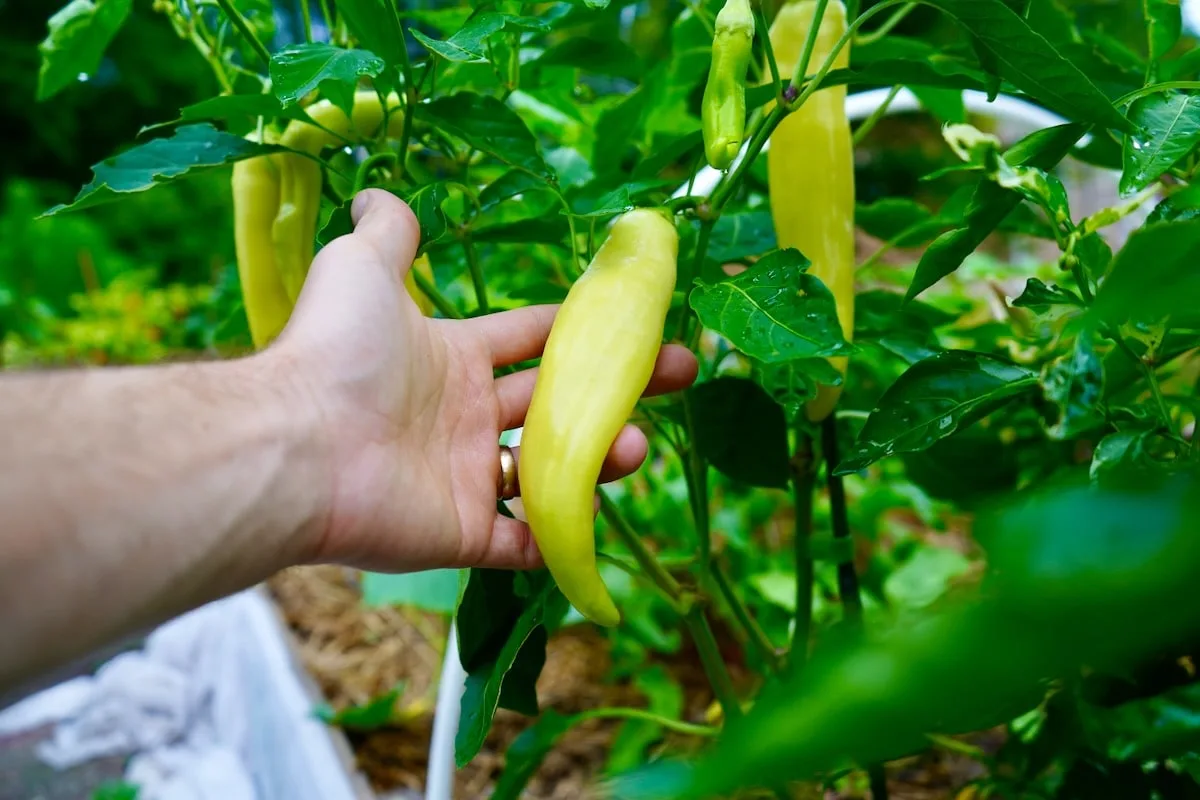
We have many posts on growing peppers, but this one will focus specifically on the banana pepper plant. The pods are larger than many other types, and they are usually harvested before fully ripening.
To make it easy, I’ll break down every step of the growing process. This includes selecting quality seeds, germinating at the right time indoors, taking care of the seedlings, moving the plants outdoors, and finally harvesting your banana peppers. Let’s get started!
1. Choose Banana Pepper Seeds
Not all banana peppers are the same! One of the most overlooked, but very important steps to growing any vegetable is seed selection. You’ll want to find the right banana pepper variety to grow in your garden, tailored to your climate and tastes.
Popular banana pepper types:
- Sweet banana peppers. If you don’t like spicy food, you’ll want to grow sweet banana peppers. The ‘Goddess’ hybrid grows especially large pods between 8-9″ long, and has some disease resistance.
- Hot banana peppers. The ‘blazing banana’ variety is known for medium heat and thick, crunchy fruits. Like most banana peppers, they are ready to harvest early in the season, making them great for colder climates.
- Hot Hungarian wax. The spicy ‘wax’ varieties were first developed from the sweet Hungarian banana pepper. Pods are usually 4-6″ long and have a medium heat level.
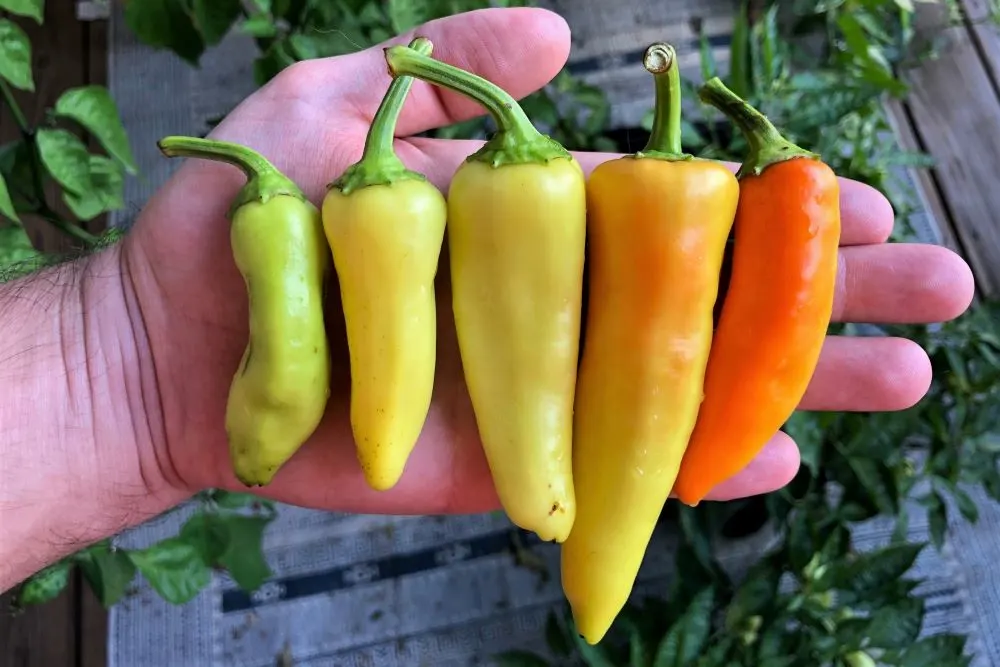
The wax pepper varieties are named for their waxy, shiny appearance. All banana pepper varieties will start out a pale green color, and ripen through to yellow, orange, and eventually red. There are many other options within the ‘wax’ family of peppers, so do some digging to find one that suits you.
2. Get Growing Supplies
Growing banana peppers will go much smoother if you plan ahead. Like any hobby, you can spend a lot of money on high-end supplies and gadgets. However, this is not necessary if you prefer to keep things simple.
For an easy start, try our pepper starter kit. It is made to last, and has all the essential containers (and seeds) for starting peppers indoors.
Required supplies:
- Seeds (or live seedlings)
- Potting soil (buy soil locally to save money)
- Seedling cells or small pots
- Large growing containers (unless growing in-ground)
- Fertilizer – If you plan to grow in containers, nutrients can get washed out by heavy rain or watering. Get some good fertilizer to keep your plants happy through to harvest.
Optional Supplies:
- Seed heating mat – This speeds up germination by keeping the soil between 80-85°F before sprouting.
- Thermometer – It is always a good idea to monitor temperature and humidity while your plants are indoors.
- Grow light – If you grow many plants, a grow light is a worthwhile investment (learn more).
- Water spray bottle
With these supplies, you can grow any pepper variety from seed. However, it isn’t just as simple as popping a seed in the soil and waiting. Your plants will need the right amount of light, water, and nutrients, as well as close attention to catch any issues that arise.
Containers or In-Ground?
Banana peppers make wonderful potted plants, but they will need a fairly large container. If you have a raised bed or an in-ground garden, I would recommend starting there. You won’t need to water as much, and plants will need little or no fertilizer.
Here are some benefits and drawbacks of each growing method:
- In-ground plants require less maintenance once they are established. When mulched, the soil will stay moist much longer than potted plants. Also, rich garden soil rarely needs fertilizer for growing vegetables. However, in-ground plants are tough to move once transplanted.
- Potted plants are great for the beginner gardener. They can be moved around easily, and can be grown on balconies and in small spaces. However, they will need much more frequent watering (often 1-2 times per day on hot summer days) and regular fertilizer.

Once you have your plan, you are ready to start growing your banana peppers. The next step is sowing your seeds, so let’s get planting!
3. Plant Seeds (At The Right Time)
Planting seeds may seem daunting to a new gardener, but it is actually pretty easy. In this step, I’ll cover when to plant seeds, how deep to plant them, and how to speed up germination.
When to plant seeds
Banana peppers are usually early producers (at least in the world of pepper plants). This means there is a bit more forgiveness for late planting. However, you should try to plant at the perfect time to ensure a timely harvest.
In general, plant banana pepper seeds indoors about 4-6 weeks before your last frost date. This varies widely based on your location, so be sure you know your last frost date.
As an example, here in Southern New England, we usually plant banana pepper seeds in late March. The plants grow indoors for about 6 weeks before beginning the transition to outside.
How to plant banana pepper seeds
Once you are ready to plant, follow these easy steps to sow your seeds. You can use a seed starter mix, or regular potting soil.
- Label your containers. If you are planting multiple varieties, it helps to give each pot a label before planting.
- Fill containers with soil. Fill your seed containers with pre-moistened soil. Just add a bit of water to the soil and mix it thoroughly. Then, fill up your pots to the top, packing down gently.
- Make a hole in the soil. Using a pencil, make a hole about ¼” deep in the soil of each seed cell. Banana pepper seeds are usually on the large side for peppers, so ¼” is the perfect depth.
- Drop 1-2 seeds in each hole. I like to plant 2 (or more) seeds to ensure at least one of them germinates.
- Cover the seeds and water. Cover up each seed with the surrounding soil so that it is planted at the ¼” depth. Use a spray bottle to gently moisten the soil surrounding the seeds.
- Keep the seeds warm and moist until they sprout. Seeds need water, oxygen, and warmth to germinate quickly. Find a warm spot to keep them and check on them daily to spritz with water.
Tip: If you don’t have a spray bottle, make sure you water gently to avoid disturbing the seed’s location.
Germination time and tips
Once seeds are planted, banana peppers should sprout within 4-7 days. Older seeds may take longer to germinate, especially in colder temperatures.
Use these tips to speed up germination:
- Use a seed heating mat. This is the best way to speed up any pepper seed’s germination. The heating mat is a heating pad that is controlled by a thermostat. Set it to 80-85°F.
- Keep the seeds wet. Each day, check your seedling cells for moisture. If the surface of the soil is beginning to dry out, spray with water several times to keep the seeds moist. Never let the seeds become dry during this process!
- Use a humidity dome. Seedling cells usually come with a tray and humidity dome for germination. This is another effective method of preventing the seeds from drying out.
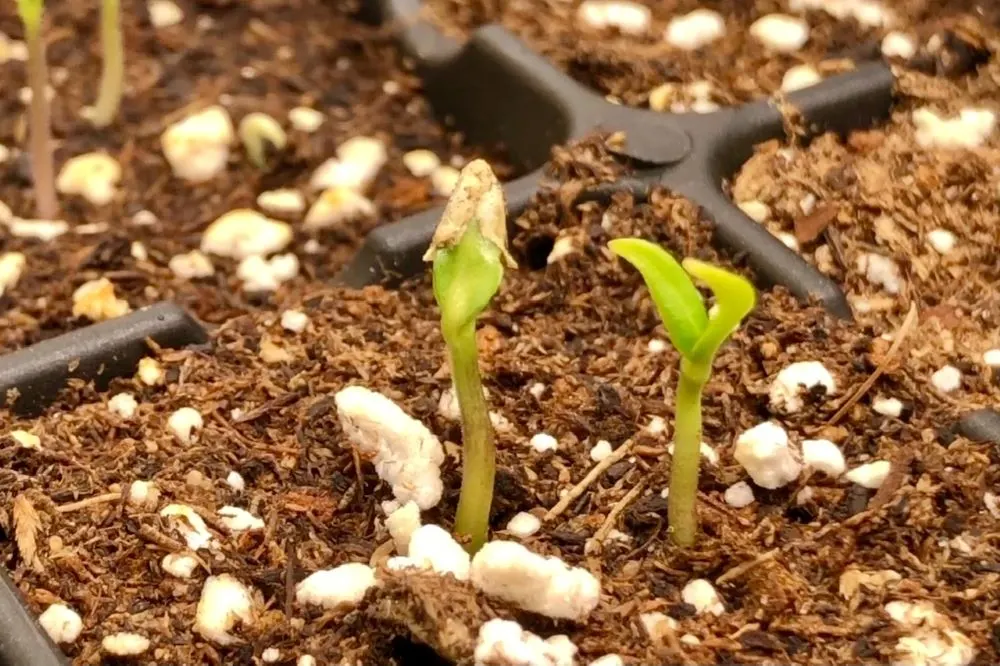
If all goes well, your seeds will sprout within a week. Once the seeds sprout, they require light to grow well. Pepper seedlings with low light will grow tall and lanky, often flopping over. Let’s move on to caring for your young banana pepper plants indoors.
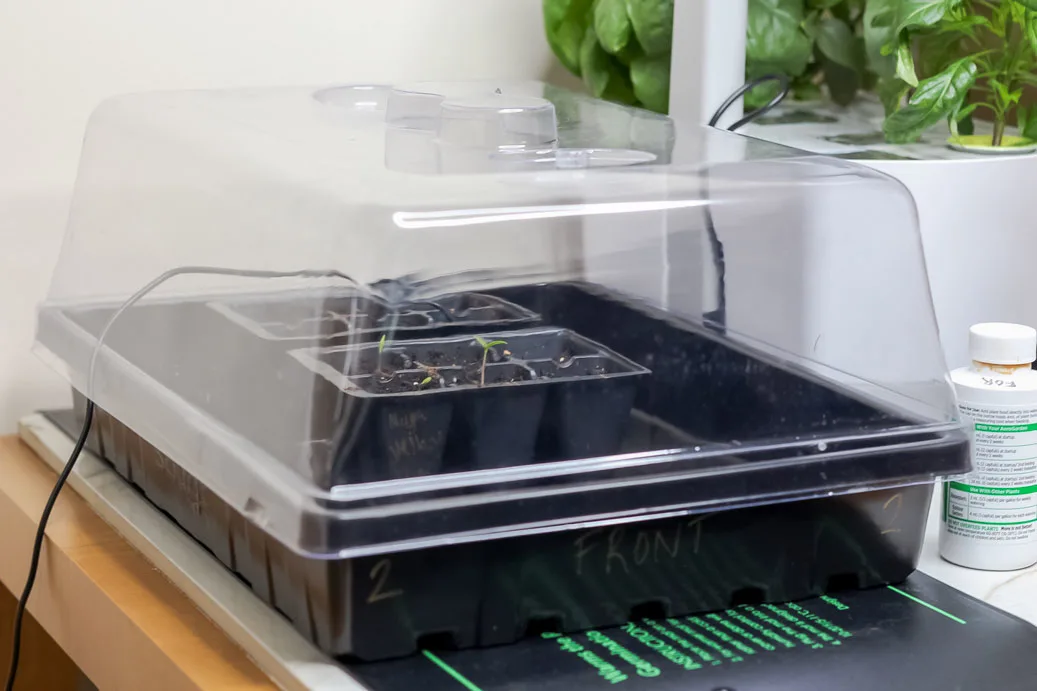
4. Provide Light and Water For Seedlings
The seedling stage of growth is an important time for your plants. Weak plants will have a tough time transitioning outdoors, and may produce later than healthy plants.
In order to keep your small plants happy, they need three things: Light, water, and nutrients.
Lighting
All plants require light, but peppers need a lot of it. From a young age, young peppers grow best with 14-16 hours of light per day. They will do okay with less, but for the strongest plants, I highly recommend using a grow light on an outlet timer.
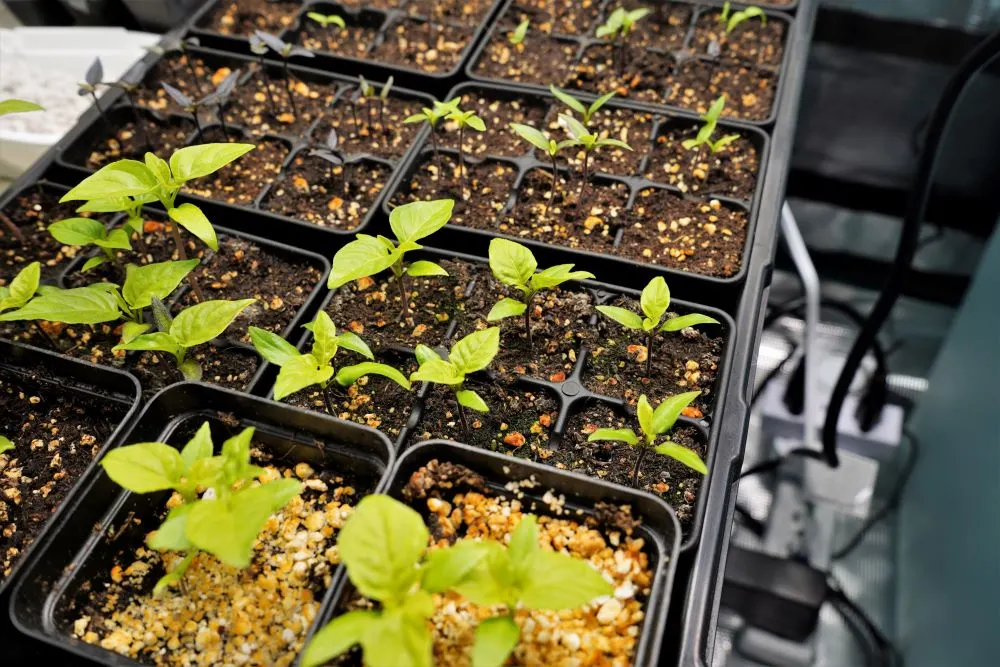
LEDs can be harsh for young banana peppers, so be sure to use the manufacturer’s recommended hanging height. With our XS1500 light, we usually start around 50% intensity at 15 inches above the leaves.
Many growers use a sunny window to grow seedlings, and this can be okay. I’d recommend starting seeds 1-2 weeks earlier in this case, and make sure you use the brightest location that you have available (South-facing is best).
Watering
For seedlings, I find it best to water from the bottom. Young seedlings are delicate, and watering from above can cause the stems to bend or even break.
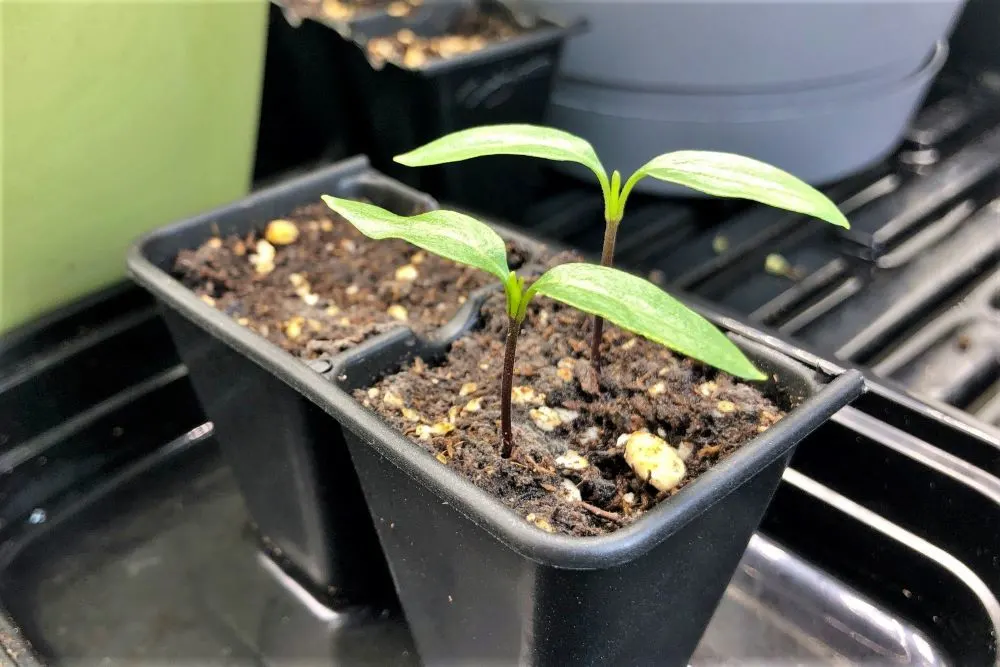
To avoid this, place your seedling cells or small pots in a container (a leftover plastic food dish works great). Fill the container with about ½ inch of water and allow the soil to soak it up from below. Once the surface of the soil is moist, pour out the excess water from the container.
Fertilizing
If you planted directly in potting soil that has nutrients, there is no need to fertilize. However, if you planted in seed starter mix, you can begin fertilizing about 1 week after the banana peppers sprout.
Learn more about fertilizing peppers here.
5. Move Plants Outside
As your banana peppers grow indoors, they should be focusing on producing healthy leaves, branches, and roots. Before the plants go outside, you do not want to see any flowers or fruits forming. If you see a baby pepper forming, pick it off!
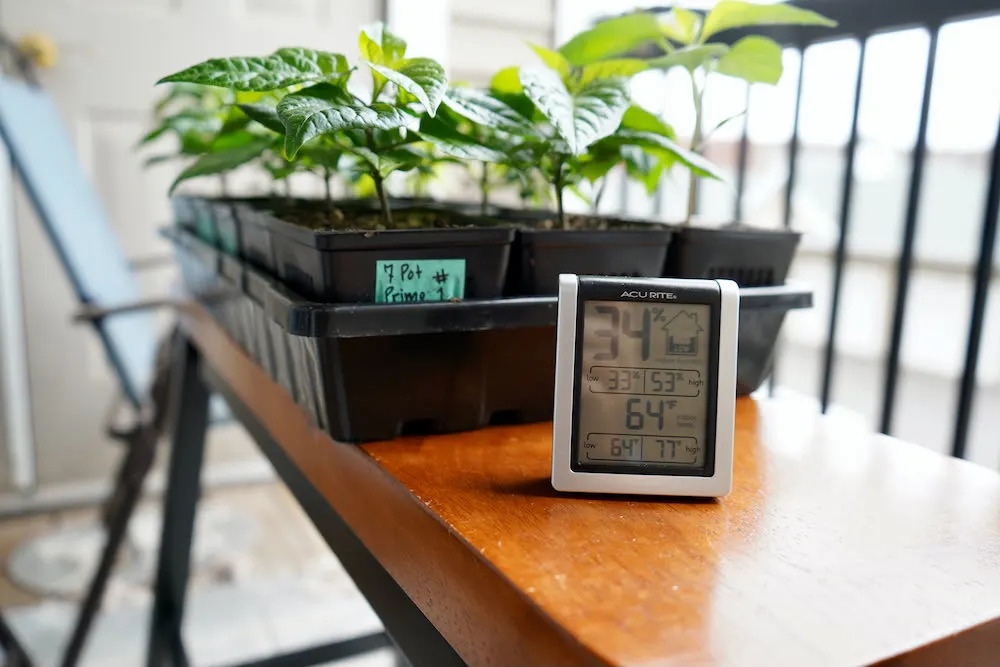
Hardening off
About 6 weeks after your peppers sprout, the weather will be warming up and you can begin to transition your banana peppers outdoors. This process is called hardening off, and must be done slowly to avoid damaging the plants.
Start with just 1 hour outdoors on a cloudy day, and then move the plants back indoors. The next day, increase the time by about 30 minutes. On the 3rd or 4th day, introduce 30 minutes of sun exposure.
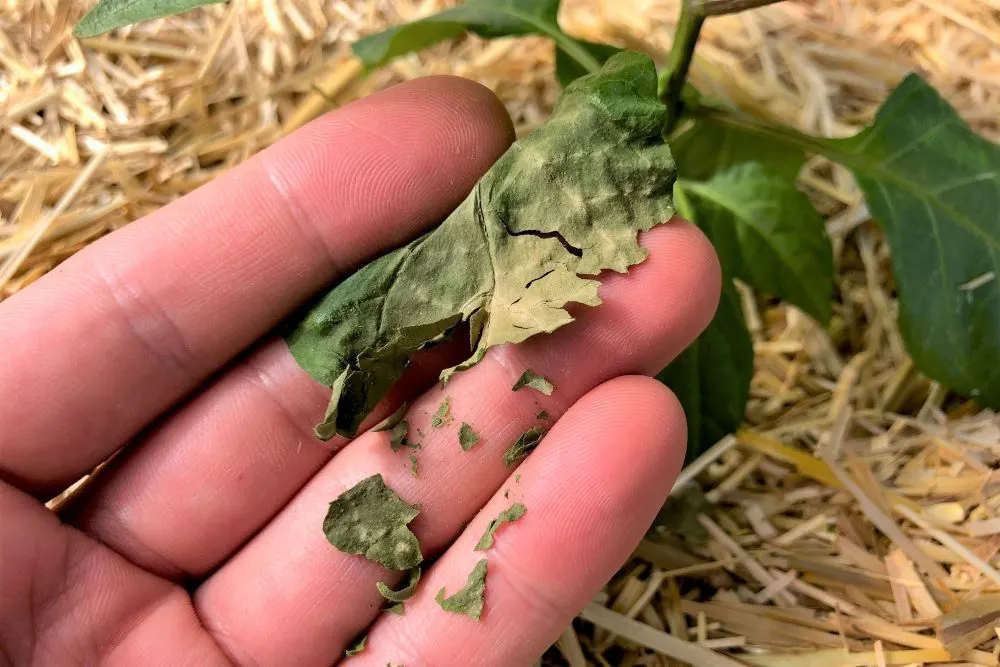
Continue increasing exposure daily until the plants can handle full sun in the location where you intend to plant. This process typically takes about 10-14 days.
Choose a sunny planting location
Choosing the spot where your plants will live is crucial. Walk around your available space and choose a sunny location with the least amount of shade. This usually means the South side of your house or any other tall obstructions.
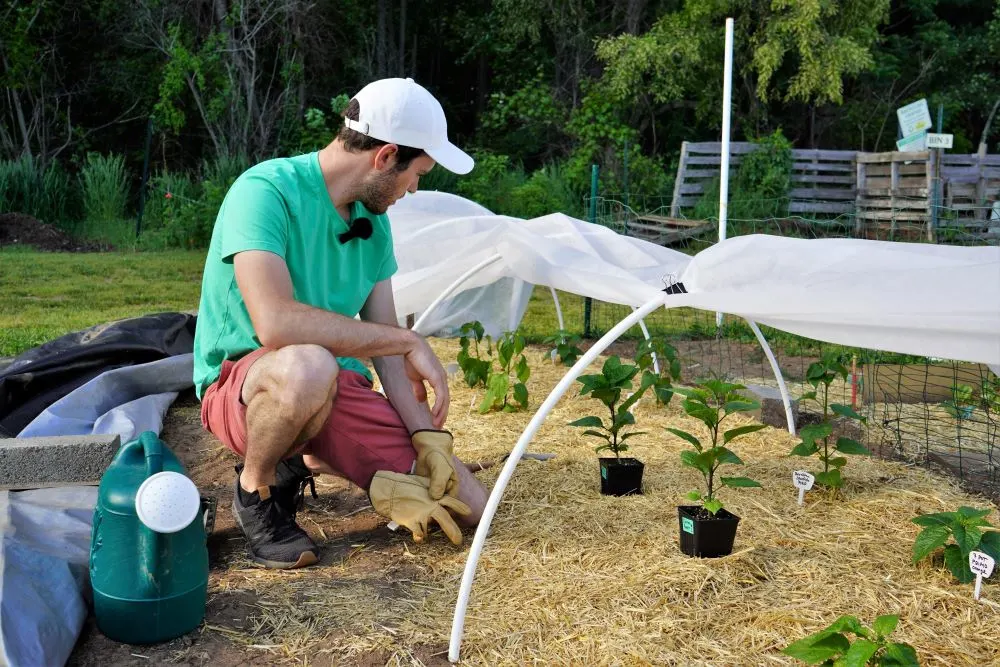
While you can grow peppers in partial shade, the flavor, heat level, and ripening time will be best in a full-sun location. This is true of most vegetable plants, so make this a priority!
Plant spacing
If you are planting in the ground, you’ll need to space your banana peppers properly. These plants usually won’t grow too wide, so they can be spaced closer to each other than larger chili varieties.
Plant banana peppers about 18 inches from each other in a row. If you are planting multiple rows, leave enough space between them for easy harvesting. The plants tend to grow tall and tree-like rather than wide and bushy.
Transplanting
The process of moving your seedlings into a larger body of soil is called transplanting. It involves moving the entire plant, soil and all, into a pre-dug hole in the soil.
Wait until the temperatures are consistently above 55°F (including overnight) before transplanting outdoors. Then, pop your seedlings into their new home, disturbing the roots as little as possible.
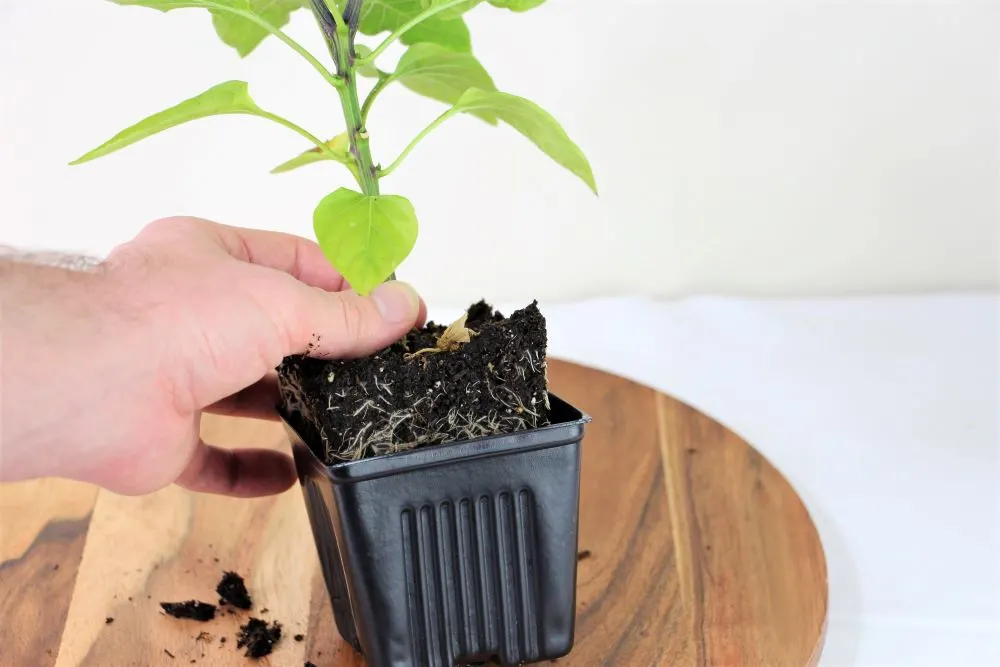
Staking
Staking can be useful if your garden is in a windy area. Younger plants are especially vulnerable to wind damage when they first move outside. Use a sturdy piece of wood or bamboo to secure the plant in place.
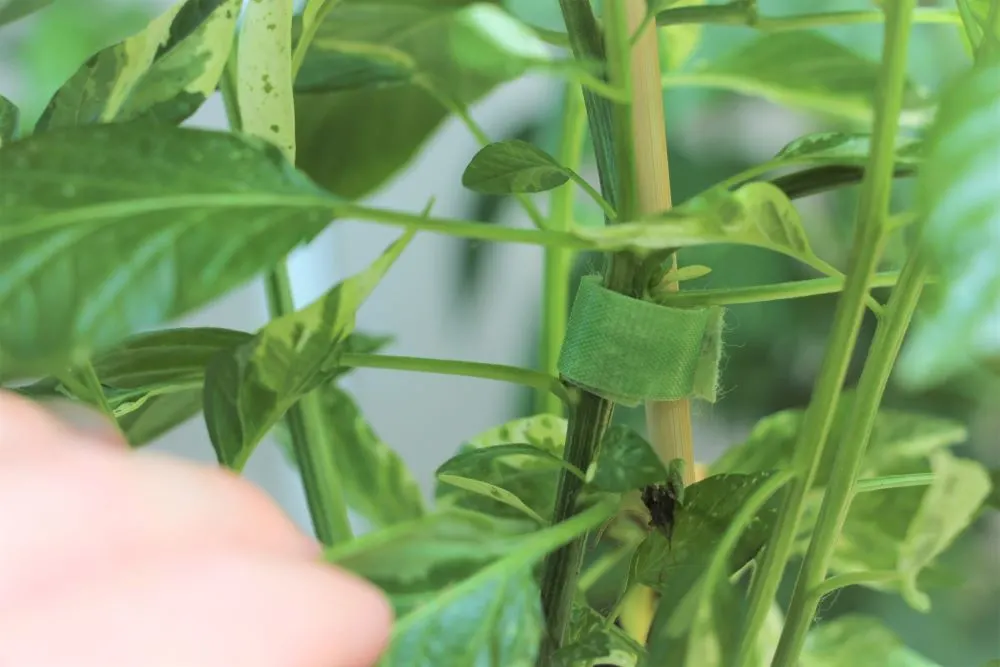
6. Water and Fertilize Regularly
Once your banana peppers are established outside, they should grow to a full, mature size quickly. If you are growing in pots, then be sure to follow a regular fertilizing regimen to ensure steady, healthy growth.
Potted plants should be watered when the first 1-2 inches of soil dries out. In cooler weather, this may be once per week. In hot weather, you will need to water much more frequently, often every day on the hottest days of the summer.
In-ground plants should be mulched after transplanting. I like to use shredded leaves or straw, because they slowly add nutrients to the soil as they decompose. A thick layer of mulch, 3-4″ deep, helps reduce the need to water and also suppresses weeds.
Once your plants reach a mature size, they should begin to produce flowers. Pepper flowers will eventually turn into the fruits, so the more flowers, the better.
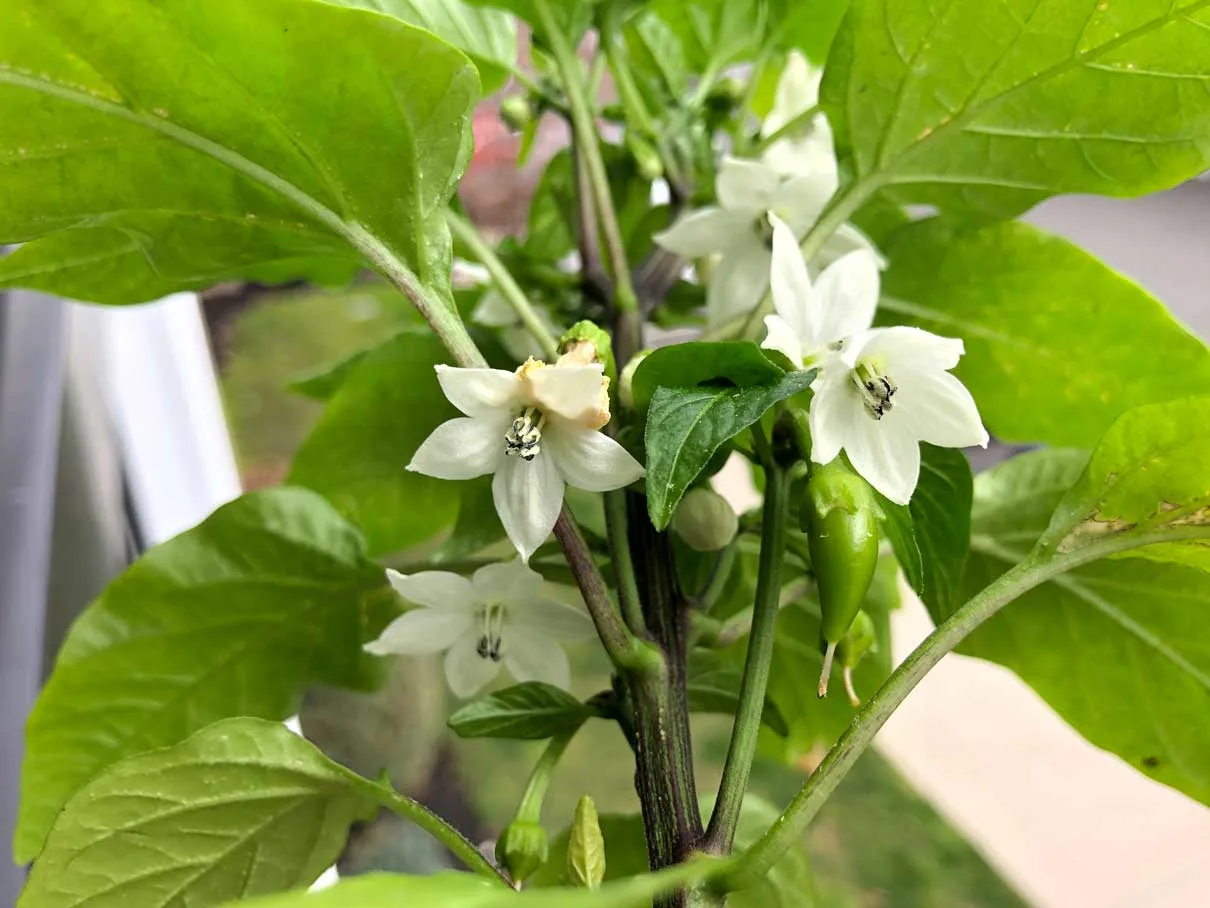
To encourage more flowers, reduce the amount of nitrogen you are providing to the plants. We usually change to a low-nitrogen fertilizer, or simply reduce the amount of fertilizer all-together. This change comes mid-season, usually about 1 month after the plants move outside.
7. Control Pests and Disease
Early spring is an important time to monitor for pests. Aphids and other sap-sucking insects will make their appearance in early spring, and can harm young pepper plants.
Make a point to look closely at the leaves, top and bottom, every day. If you notice an infestation, do what you can to control it.
One of the best ways to deal with pests is to plant companion plants with your banana peppers. We grow things like yarrow, alyssum, and other flowers to attract both pollinators and beneficial predators.
Disease can be an even greater issue, especially in hot, damp regions. Learn about what plant diseases are common in your area, and try to buy a banana pepper hybrid variety that is resistant.
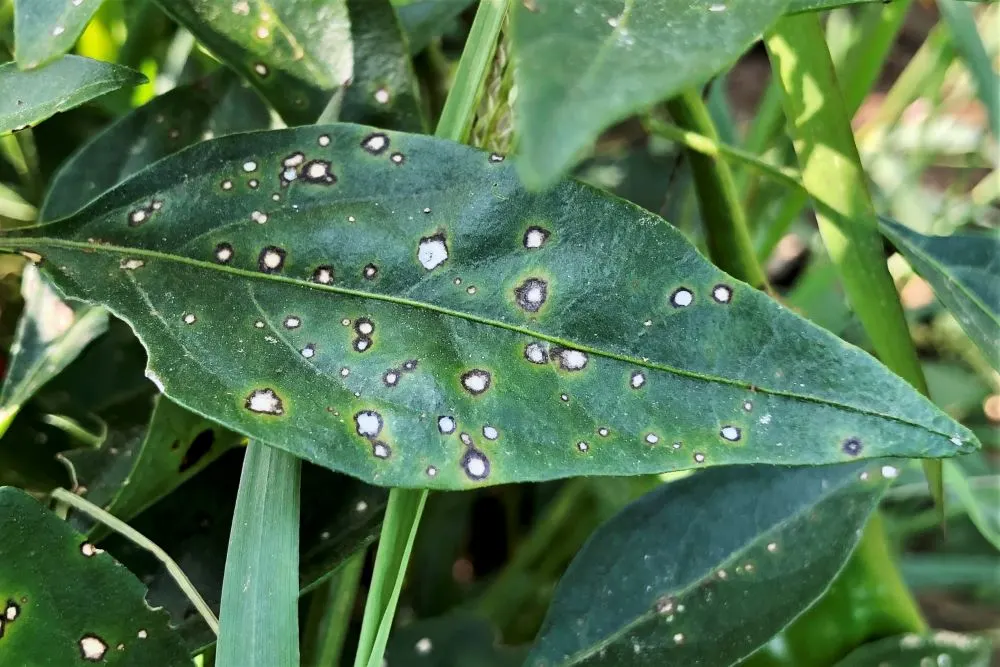
If your plants do get disease, try to diagnose it before taking action. Some fungal diseases can be slowed down with treatment, while some viruses will kill the plants. Learn more about pepper diseases here.
8. Harvest Your Banana Peppers
After about 8-10 weeks outdoors, your banana peppers should ready to harvest. Banana peppers are unique in the pepper world, as they are typically picked before they are fully ripe.
The best time to harvest a banana pepper is when it is fully grown in size and has a yellow color to it. Immature pods will be light green, while fully ripened pods will be red. You want to pick right in the middle for maximum flavor and crunch level.
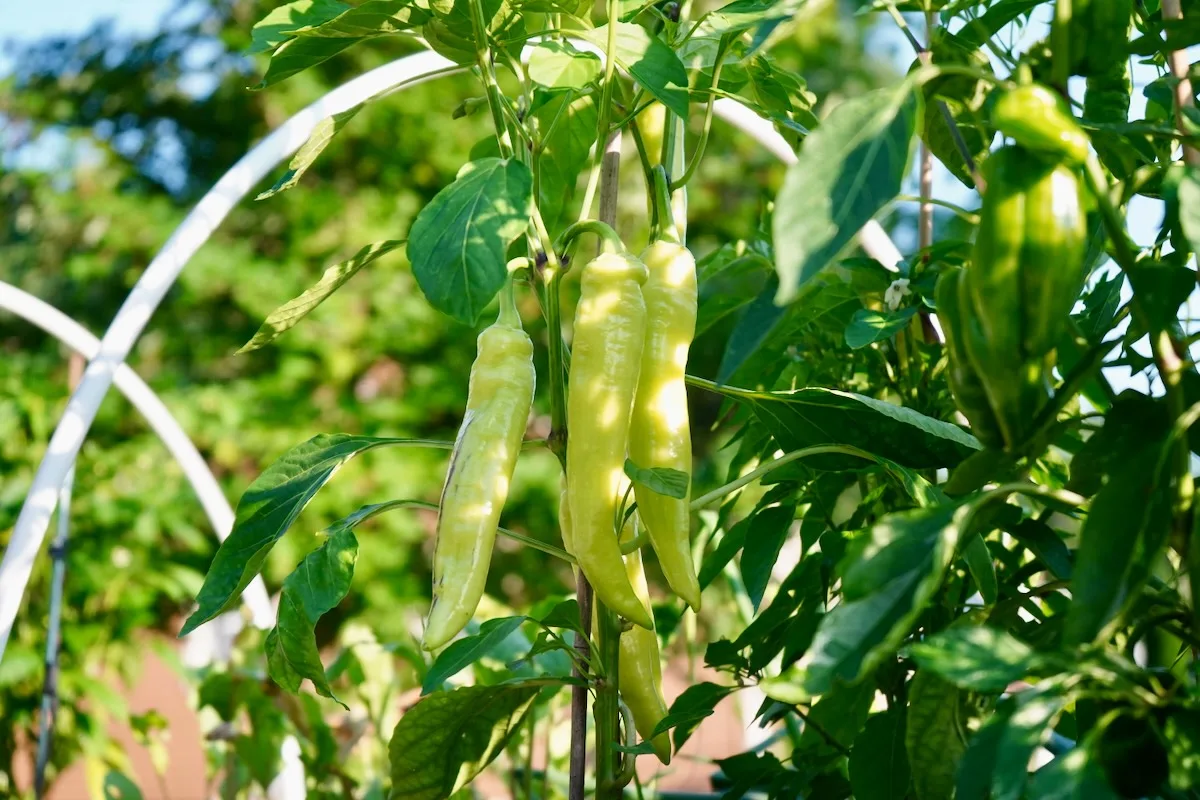
Note: If you plan to save the seeds from your banana peppers, allow the peppers to turn completely red before picking them. The seeds require more time to develop and mature before harvesting.
Succession planting
Since banana peppers are harvested so early (for peppers), they are one of the few pepper types that can be succession planted. If you want consistent harvests for several weeks, plant new seeds weekly in the spring.
I like to plant 2 plants each week starting in mid-March and ending in mid-April. Then, come August, you should have new banana peppers ready to pick every week until winter arrives!
What To Do With Banana Peppers
Once you start picking banana peppers, you’ll probably have more than you know what to do with. Here are a few excellent ways to use your banana peppers up:
- Pickle them. Try our pickled banana pepper recipe to make the most delicious, crunchy snack. These are perfect on sandwiches, in salads, or on cheese and crackers. This is also a great way to preserve your banana peppers for months in the refrigerator.
- Make a hot sauce. Banana peppers may not seem like the ideal candidate for hot sauce, but they make a delicious condiment! Try our banana pepper hot sauce here.
- Stuff them. Try stuffing your banana peppers with the same mixture and roasting to savory perfection. There are many ways to stuff banana peppers to delicious perfection.
- Freeze them. If you want a quick way to preserve your harvests for later use, try freezing them. We use a vacuum sealer to freeze our pepper harvests every year. The frozen peppers can be roasted or fried, straight out of the freezer.
- Use them in tasty meal. Check out our list of banana pepper recipes for 10+ great options for cooking with banana peppers!
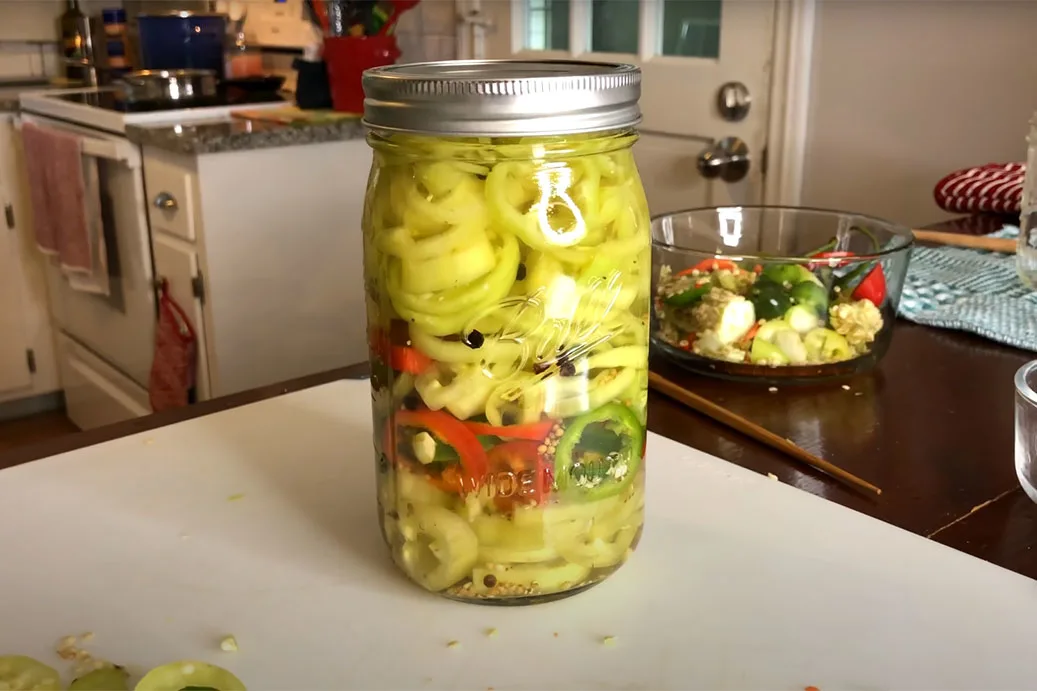
I hope this article helped you to learn how to grow banana peppers from seed to harvest. There is nothing more satisfying than harvesting your first pepper, months after you planted a tiny seed. Keep up the great work, and happy growing!

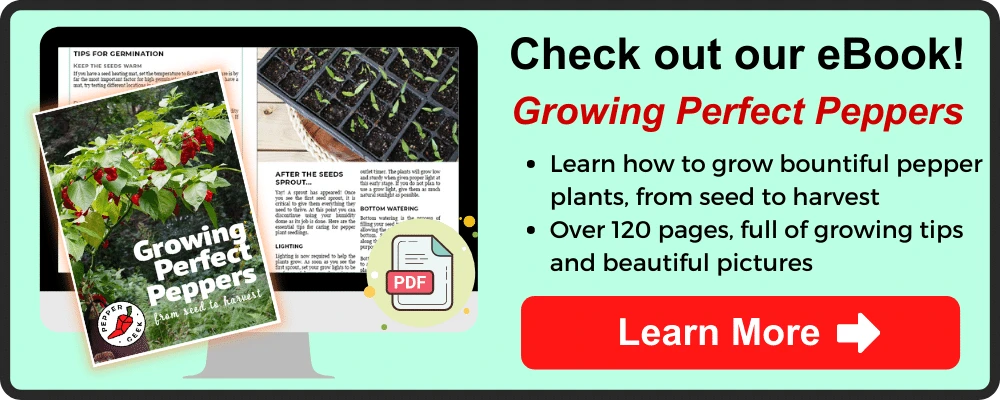
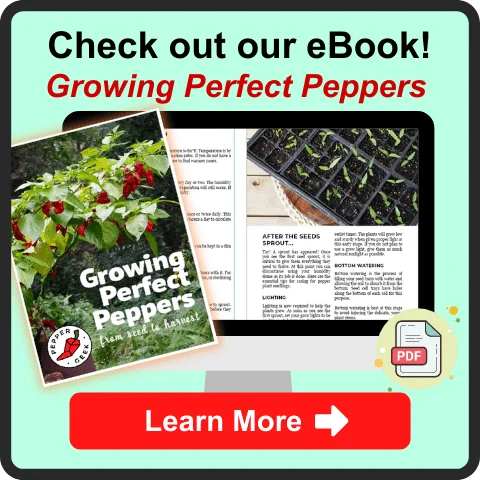

Joel
Saturday 26th of August 2023
So we planted our peppers in mid-june where in Western Pennsylvania. They've grown they're in a raised bed and they're doing very well we get big and juicy light green peppers. Our question is you said that we should be harvesting them at a yellow in color at 8 to 10 weeks and we're at 8 to 10 weeks and still a light green. We have one that went from light green to red. How long should we wait to harvest our peppers?
peppergeek
Tuesday 29th of August 2023
If they're banana peppers, I like to harvest when they are a nice pale yellow color. This usually happens around 1-2 weeks after they reach a mature size. If you wait for them to turn red, they will soften quite a bit, making them less crunchy when pickled. Still delicious fresh, but not ideal for preservation. So, pick them about 1-2 weeks after reaching their full size
Patrick
Monday 3rd of July 2023
Woukd you be willing to write or video a pepper "chart" about the sizes of pepper plants? Maybe a roundabout guide of their usual sizes at maturity, or milestone sizes throughout their grow cycle.
don boots
Sunday 5th of March 2023
seems march 15 is kinda early to start in new england. i start april 10 pittsburgh pa. after 6 weeks u say harden off. it’s april 30. we get frost till june 1
Patrick
Monday 3rd of July 2023
@don boots, it's different for everyone. What he mentions is his zone and area. It's just a guideline for the novice to think about where they are and how they might approach it. I can't believe you get frost till June 1st. When is your fall frost date?
Aaron
Friday 3rd of March 2023
Calvin, will you recommend an open-pollinated variety of sweet banana pepper? I like to save my seeds from season-to-season and the “Goddess” variety recommended in this article is an F1 hybrid.
peppergeek
Sunday 5th of March 2023
Have you tried the sweet banana from Rare Seeds? It isn't nearly as impressive as the Goddess hybrid, but similar in flavor.